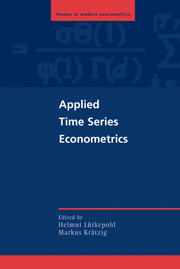Book contents
- Frontmatter
- Contents
- Preface
- Notation and Abbreviations
- List of Contributors
- 1 Initial Tasks and Overview
- 2 Univariate Time Series Analysis
- 3 Vector Autoregressive and Vector Error Correction Models
- 4 Structural Vector Autoregressive Modeling and Impulse Responses
- 5 Conditional Heteroskedasticity
- 6 Smooth Transition Regression Modeling
- 7 Nonparametric Time Series Modeling
- 8 The Software JMu⌉Ti
- References
- Index
Preface
Published online by Cambridge University Press: 23 November 2009
- Frontmatter
- Contents
- Preface
- Notation and Abbreviations
- List of Contributors
- 1 Initial Tasks and Overview
- 2 Univariate Time Series Analysis
- 3 Vector Autoregressive and Vector Error Correction Models
- 4 Structural Vector Autoregressive Modeling and Impulse Responses
- 5 Conditional Heteroskedasticity
- 6 Smooth Transition Regression Modeling
- 7 Nonparametric Time Series Modeling
- 8 The Software JMu⌉Ti
- References
- Index
Summary
Time series econometrics is a rapidly evolving field. In particular, the cointegration revolution has had a substantial impact on applied work. As a consequence of the fast development there are no textbooks that cover the full range of methods in current use and at the same time explain how to proceed in applied work. This gap in the literature motivates the present volume. It is not an introductory time series textbook but assumes that the reader has some background in time series analysis. Therefore the methods are only sketched briefly to remind the reader of the underlying ideas. Thus the book is meant to be useful as a reference for a reader who has some methodological background and wants to do empirical work. It may also be used as a textbook for a course on applied time series econometrics if the students have sufficient background knowledge or if the instructor fills in the missing theory.
The coverage of topics is partly dictated by recent methodological developments. For example, unit root and cointegration analysis are a must for a time series econometrician, and consequently these topics are the central part of Chapters 2 and 3. Other topics include structural vector autoregressions (Chapter 4), conditional heteroskedasticity (Chapter 5), and nonlinear and nonparametric time series models (Chapters 6 and 7). The choice of topics reflects the interests and experiences of the authors. We are not claiming to cover only the most popular methods in current use. In fact, some of the methods have not been used very much in applied studies but have a great potential for the future. This holds, for example, for the nonparametric methods.
- Type
- Chapter
- Information
- Applied Time Series Econometrics , pp. xv - xviiiPublisher: Cambridge University PressPrint publication year: 2004
- 27
- Cited by



